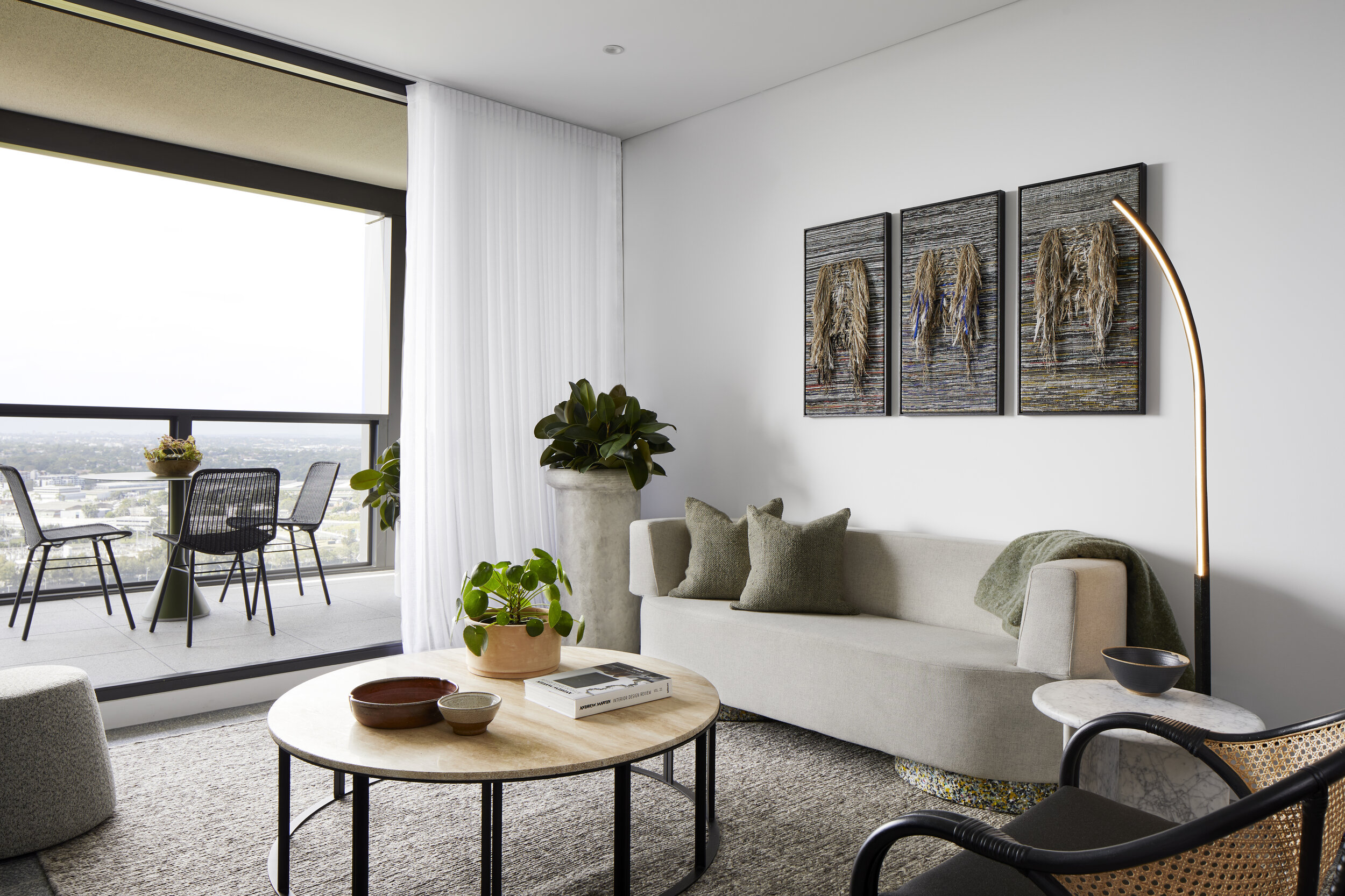MIRVAC PAVILIONS APARTMENT
Mirvac Pavilions Apartment is a collaborative and sustainable initiative revealed by the UNSW SMaRT Centre and industry partner Mirvac. Crossing Threads were thrilled to showcase in this industry-first apartment made using waste materials that have the potential to revolutionise home construction.
Utilising products that originate from waste glass and textiles, Mirvac engaged with various suppliers to create innovative ways to transform household waste into a valuable resource. The ‘green ceramics’, used for the first time as a construction material, are the result of a collaboration that began in 2019 between Mirvac and the UNSW Centre of Sustainable Materials Research and Technology (SMaRT), led by UNSW Professor Veena Sahajwalla, a global pioneer in waste technology.
Attended by the NSW Energy and Environment Minister Matt Kean at the Pavilions apartment at Sydney Olympic Park, everything from the flooring, wall tiles, kitchen and lighting features, and furniture and artworks, made from waste glass and textiles.
The revolutionary Mirvac Pavilions apartment at Sydney Olympic Park unveiled by UNSW Centre of Sustainable Materials Research and Technology (SMaRT) and Mirvac. Crossing Threads’ framed textile triptych titled ‘REWILD’ on display. Styling by Steve Cordony and photographed by Dave Wheeler.
Leading interior stylist Steve Cordony partnered with Mirvac to style and create the look and feel of the apartment, curating all of the additional furniture and accessory pieces having a sustainable focus. Amongst the selection was Crossing Threads’ framed tapestry triptych titled ‘REWILD’, to become part of interior decor. As part of Crossing Threads’ ethos to tread lighter on the environment and re-use as many materials where possible, this triptych celebrates resourcefulness and the practice of ‘reuse, repurpose, recycle’.
Handwoven by Lauren Hernandez, REWILD’s sheds light on the disastrous impact of plastic on the natural environment, woven primarily from a range of recycled materials that include hand-cut plastic mailing bags and upcycled upholstery off-cuts. The artist pieces together remnants of the synthetic world by repurposing plastic mailing bags to create a new identity. Bushy hemp and linen are juxtaposed against man-made materials, highlighting the tactile differences and materiality. The dishevelled and untamed manes pierce through the tightly woven plastic, breaking free and spreading its wings.
Crossing Threads’ handwoven triptych titled ‘REWILD’ on display, teaming beautifully with the accompanying decor at Mirvac Pavilions Apartment. Styling by Steve Cordony and photographed by Dave Wheeler.
Crossing Threads artwork ‘REWILD’ celebrates the use of upcycled plastic mailing bags, upholstery off-cuts and natural fibres such as raw hemp and linen.
The combination of two dissimilar waste sources – glass and textiles – in the MICROfactorie process creates an entirely new product that makes the technology distinct from other recycled products.
The wall artwork and tabletop are features of the display apartment that showcases the possibilities of green ceramics.
The kitchen splashback, the front of the island bench and the tubular light fittings on display in the apartment were manufactured using green ceramics.
The MICROfactorie process led by Professor Veena, takes problematic waste materials and ‘reforms’ them into entirely new ‘green ceramics’ and other products for the built environment through a combination of heat and compression. In the Pavilions apartment, green ceramic tiles are used for the first time as a building material. All tiles are made from a combination of yellow-bin glass and textiles, both considered problem waste streams despite their inherent qualities. Green ceramics have been applied to flooring, kitchen splashback and island front, shelving, feature walls, artwork, light fittings and furniture.
Mirvac CEO & Managing Director, Susan Lloyd-Hurwitz, told the gathering of property, construction, design and sustainability leaders that it was time for the industry to find a more sustainable way to build.
"I remember just being blown away by the variety of things that she’d been able to create out of what would have been considered waste materials,’’ says Mirvac CEO Susan Lloyd-Hurwitz. But the pressure is on to transform her latest invention into a workable idea for business and get consumers interested.
To learn more about this initiative, visit the links below:
Mirvac Pavilions Apartment unveiled by Mirvac and UNSW Centre of Sustainable Materials Research and Technology (SMaRT)
Styling by Steve Cordony
Photographed by Dave Wheeler







